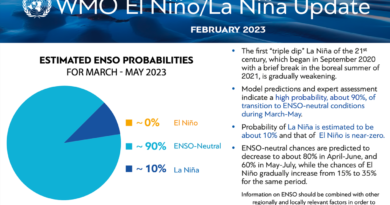El Niño Weakening, but Ongoing Impacts on Global Climate Persist
06 March 2024, US: The 2023-24 El Niño, which is among the five strongest on record, has now reached its peak and is gradually weakening. Despite its diminishing strength, the effects of El Niño on the global climate are expected to continue in the coming months. The World Meteorological Organization (WMO) has released an update that highlights the persistence of above-normal temperatures over most land areas between March and May, fueled by the heat trapped by greenhouse gases from human activities. This article explores the current status of El Niño and its lasting impact on the global climate.
El Niño is a recurring climate pattern that occurs every two to seven years and typically lasts for nine to 12 months. It is characterized by a warming of the ocean surface in the central and eastern tropical Pacific Ocean. El Niño influences weather and storm patterns in different parts of the world. However, it is important to note that El Niño occurs within the context of a changing climate influenced by human activities.
The Secretary-General of the WMO, Celeste Saulo, emphasizes that while El Niño has contributed to record-breaking temperatures, the primary driver of global warming is the accumulation of heat-trapping greenhouse gases. While the equatorial Pacific Ocean’s surface temperatures reflect El Niño, exceptionally high sea surface temperatures have persisted in other regions for the past ten months. In fact, January 2024 witnessed the highest sea-surface temperature on record for that month, indicating that the unusual warmth cannot be solely attributed to El Niño.
Although El Niño’s impact is expected to be most significant in its second year, which is 2024 in this case, the weakening El Niño is still anticipated to contribute to above-normal sea-surface temperatures over a significant portion of the global oceans. As a result, the next three months are projected to experience above-normal temperatures over most land areas, and regional rainfall patterns will be influenced by the ongoing El Niño.
Looking ahead, the WMO’s Global Seasonal Climate Update suggests a 60% chance of El Niño persisting from March to May, followed by an 80% chance of neutral conditions (neither El Niño nor La Niña) from April to June. The development of La Niña later in the year remains uncertain. Continued monitoring and analysis will be crucial in determining its potential impact.
In conclusion, while El Niño is gradually weakening, its lasting effects on the global climate persist. The combination of the weakening El Niño and the presence of greenhouse gases from human activities contribute to above-normal temperatures and altered rainfall patterns. Understanding these climate dynamics is crucial for effectively addressing the challenges posed by global warming. Continued research, monitoring, and international cooperation will play a vital role in better understanding and predicting the behavior of El Niño and its implications for our planet.
Also Read: Indian Cotton Prices and Outlook for March 2024: A Mixed Bag for Cotton Producers
(For Latest Agriculture News & Updates, follow Krishak Jagat on Google News)















